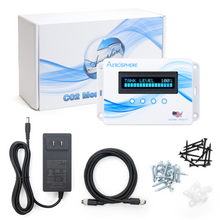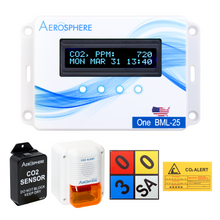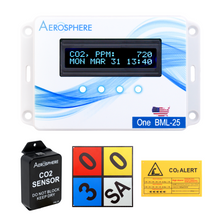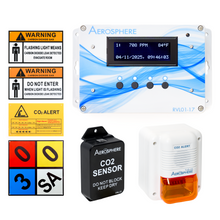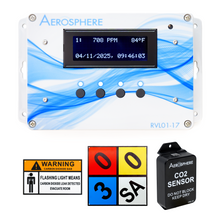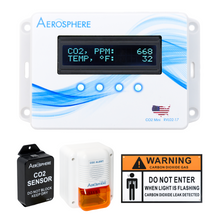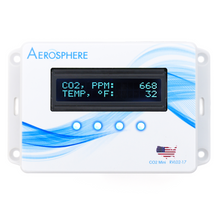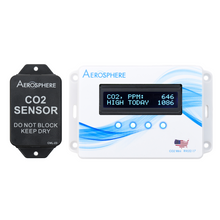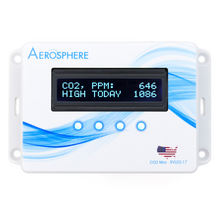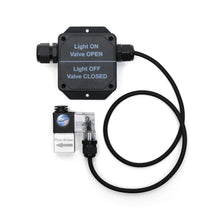How to Improve Indoor Air Quality in Winter
Winter often traps more than just warmth indoors. It seals in pollutants, raises CO2 levels, and reduces ventilation, all of which can impact your health and comfort. From humidity control and filter maintenance to reducing VOCs and tracking air quality, this guide covers simple and practical steps to keep your home’s air cleaner, healthier, and more breathable during the colder months.

When temperatures drop, windows close, heaters turn on, and we spend far more time indoors. While cozying up inside is a natural part of winter, it also comes with an often-overlooked downside: poor indoor air quality. Stale, dry air, increased carbon dioxide (CO2) levels, and a buildup of indoor pollutants can all affect how we feel and function during the colder months.
According to the American Lung Association, indoor air can contain two to five times more pollution than outdoor air. Because of the cold weather, we tend to stay inside, therefore sealing up our homes and trapping pollutants like mold, dust, particulate matter, and volatile organic compounds (VOCs) inside.
Improving indoor air quality in winter isn’t just about comfort. It’s also about creating a healthier, and safer environment for you and your family. This guide will explain why indoor air quality often worsens in winter, how to spot the signs of a problem, and what practical steps you can take to make the air inside your home cleaner and fresher.
Why Indoor Air Quality Gets Worse in Winter
1. Reduced Ventilation
During the warmer months, natural ventilation like open windows and doors allows fresh air to circulate and dilute indoor pollutants. But during winter, most homes are sealed tight to conserve heat. This traps air inside, along with everything in it: CO2, dust, allergens, chemicals, and moisture.
2. Increased CO2 Concentration and Air Pollutants
Every time we exhale, we release CO2 into the air. In well-ventilated spaces, that is not a problem. But in sealed winter homes, CO2 levels can quickly rise, leading to symptoms like headaches, fatigue, and poor concentration. High CO2 levels do not mean there is a dangerous gas leak. They simply signal that fresh air is not circulating enough.
In the winter, VOC concentrations increase due to the time we spent indoors and the lack of practice of opening doors and windows. According to the EPA, many of our air pollutants come from indoor sources such as scented candles, wood-burning fireplaces, and different types of cleaning products. Breathing in VOCs can irritate our eyes, nose, and throat, can cause difficulty breathing. In serious cases, it can damage the central nervous system and other organs.
3. Dry Air and Heating Systems
Most heating systems dry out indoor air, which can irritate the respiratory system, dry out skin, and make it easier for viruses to spread. Additionally, older furnaces or unmaintained systems may circulate dust, mold spores, and other pollutants.
4. More Time Indoors
We spend up to 90% of our time indoors during winter. That increased exposure means any air quality issues, even mild ones, can have a much bigger impact on health and comfort.

How Poor Indoor Air Quality Affects Health
The EPA addresses that there are multiple health effects associated with indoor air pollutants, including irritation of the eyes, nose, and throat; headaches, dizziness, and fatigue; and respiratory disease, heart disease and cancer.
Improving the air you breathe during the colder months does not require expensive renovations or complicated systems. The biggest difference usually comes from small, consistent changes to how you maintain, monitor, and manage your home environment. Here are the most impactful steps you can take this winter to keep your indoor air clean, fresh, and healthy.
1. Install a CO2 or Air Quality Monitor
You cannot improve what you do not measure, and this is especially true with indoor air quality. Most homes experience rising CO2 levels during the winter because windows stay closed and ventilation is reduced. These changes are invisible and odorless, so without a monitor, there is no reliable way to know when air quality is declining.
How to do it:
- Place CO2 or air quality monitors in rooms where people spend the most time, such as bedrooms, home offices, or living spaces.
- Look for devices that measure multiple metrics, like CO2, humidity, temperature, and volatile organic compounds (VOCs).
- Many modern monitors connect to phone apps, sending alerts when levels rise or conditions change.
- Track readings over time to see how daily activities affect air quality and identify patterns.
Why it matters:
High CO2 levels do not just make you tired. They can impact focus, slow decision-making, and affect sleep quality. Monitoring gives you a clear signal of when to ventilate or adjust conditions, which can dramatically improve how your home feels and how you function in it.
Tip:
Our Aerosphere® CO2 Indoor Air Quality Monitor Kit is designed specifically for continuous indoor monitoring. Highly used by schools, it measures CO2 and temperature in real time and alerts you before air quality drops below healthy levels, making it easier to ventilate and improve conditions before problems start. Shop our latest product here!
2. Replace and Maintain Air Filters Regularly
Heating systems run more frequently in winter, circulating air throughout your home. If the filters inside your furnace or HVAC system are dirty, they spread dust, allergens, and particles instead of trapping them. This reduces air quality and forces your system to work harder, increasing energy use and costs.
How to do it:
- Replace furnace filters at least every one to three months during the heating season. If you have pets or live in a dusty area, check them more often.
- Vacuum or gently wipe air vents and return grilles to remove surface dust that can blow back into the air.
- If you use portable air purifiers, follow the manufacturer’s recommendations for filter cleaning or replacement.
- Schedule an annual HVAC inspection before peak winter to ensure ducts and components are clean and functioning properly.
Why it matters:
Clean filters improve airflow and trap harmful particles like pollen, pet dander, and dust mites. They also help extend the life of your HVAC system and keep it running efficiently. A well-maintained system can significantly reduce the amount of airborne irritants in your home.
3. Keep Humidity Balanced for Better Comfort and Health
Winter air is often dry, and indoor heating systems make it worse. Low humidity can cause dry skin, scratchy throats, and irritated sinuses. On the other hand, too much humidity creates an ideal environment for mold and dust mites, both of which can degrade air quality. Based on the research of "Clearing the Air: Asthma and Indoor Air Exposures", it was found that dampness increases allergen burden, leading to increased risk of developing asthma.
How to do it:
- Use a simple hygrometer or a combined air quality monitor to track indoor humidity levels. Aim for a range of 30% to 50%.
- If your air is too dry, run a cool-mist humidifier in bedrooms or living spaces. For large homes, consider a whole-house humidifier connected to your HVAC system.
- If humidity is too high, use exhaust fans, crack a window briefly, or run a dehumidifier. This is especially important in basements, bathrooms, and kitchens.
- Reduce unnecessary moisture by venting clothes dryers outside, covering pots when boiling water, and running fans after showers.
Why it matters:
Proper humidity keeps your respiratory system healthy and helps your body filter airborne particles more effectively. Balanced moisture levels also prevent furniture from cracking, protect wood floors, and make your home feel warmer without raising the thermostat.

4. Refresh Bedding, Curtains, and Soft Surfaces
Fabrics are excellent at trapping dust, dander, and other pollutants. In winter, when windows are closed and air circulation is limited, these particles accumulate and recirculate into the air every time you sit, lie down, or move around. Regularly refreshing soft surfaces can significantly reduce airborne contaminants.
How to do it:
- Wash bedding, pillowcases, and throw blankets weekly in hot water to eliminate dust mites and allergens.
- Vacuum upholstered furniture and fabric surfaces with a HEPA-filter vacuum cleaner.
- Occasionally hang bedding or cushions outside for a few hours on a dry, sunny day to air them out naturally.
- Open bedroom windows for 10 to 15 minutes while you make the bed to replace stale overnight air with fresh outdoor air.
Why it matters:
Because we spend nearly a third of our lives sleeping, air quality in bedrooms is especially important. Refreshing soft surfaces helps reduce allergens, improves sleep quality, and keeps the air from feeling heavy or stale.
5. Limit Everyday Pollutants Indoors
Many air quality problems come from ordinary activities and products used around the house. Reducing these sources is one of the easiest ways to create cleaner air without relying solely on ventilation or filtration.
How to do it:
- Choose cleaning products, paints, and adhesives labeled “low-VOC” or “non-toxic.”
- Store chemicals, paints, and fuels in a garage, shed, or outdoor storage area rather than inside the home.
- Minimize the use of candles, incense, and wood-burning fireplaces, which release fine particles and soot into the air.
- Never smoke indoors. Even occasional smoking leaves long-lasting pollutants that cling to surfaces and continue to release into the air.
Why it matters:
Preventing pollutants from entering the air in the first place is far more effective than trying to filter them out later. Small lifestyle adjustments can significantly improve overall air quality and make your home healthier without any extra equipment.

6. Use Plants Strategically (But Do Not Overdo It)
Houseplants are often promoted as natural air purifiers, and while their impact is modest, they can still contribute to a healthier indoor environment. Plants can absorb some airborne chemicals, produce small amounts of oxygen, and add humidity to dry indoor air. However, too many plants or overwatering can cause more problems than they solve.
How to do it:
- Choose low-maintenance plants known for air-improving qualities, such as snake plants, spider plants, or peace lilies.
- Place them in living areas or near workspaces where you spend time, rather than cluttering bedrooms.
- Water plants carefully and allow soil to dry slightly between waterings to prevent mold growth.
- Dust leaves regularly so they can effectively exchange gases and continue absorbing pollutants.
Why it matters:
Plants should be seen as a helpful addition, not a complete solution. A few well-chosen plants can improve comfort and aesthetics while slightly enhancing air quality, but they work best as part of a larger air quality strategy.
Learn more about the best types of plants for every room in your house in our article regarding air purifying plants for your home.
7. Establish a Weekly Air Quality Routine
Consistency is key when it comes to maintaining cleaner air. Instead of trying to do everything at once, create a simple weekly routine that keeps conditions under control year-round.
How to do it:
- Daily: Crack windows open for 5 to 10 minutes, especially after cooking, cleaning, or waking up.
- Weekly: Vacuum floors and upholstery, wash bedding, and wipe down surfaces.
- Monthly: Check humidity levels, replace filters, and review CO2 monitor data.
- Seasonally: Deep clean rugs, curtains, and vents before winter and spring.
Why it matters:
By making air quality part of your regular home care schedule, you prevent buildup before it becomes a problem. These small, consistent steps maintain a healthier environment without requiring big one-time efforts.
Learn more about the natural ways to improve your indoor air quality without an air purifier in one of our latest article!
Small Actions Lead to Big Results
Winter may make it harder to get fresh air, but improving indoor air quality is absolutely possible with small, consistent habits. By focusing on measurable changes like monitoring CO2, replacing filters, managing humidity, and limiting pollutants, you can transform how your home feels and how you feel in it. These steps are simple enough for any household yet powerful enough to make a noticeable difference in comfort, health, and quality of life all season long.


